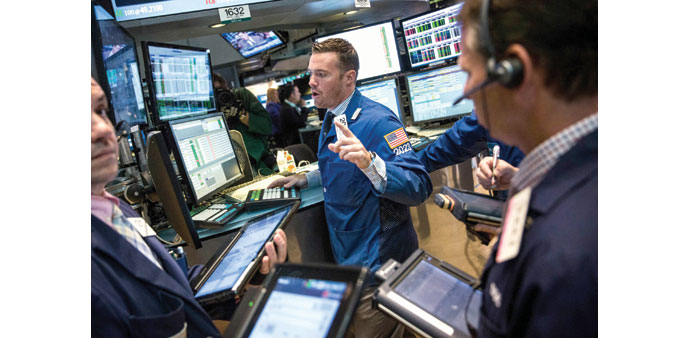Traders work on the floor of the New York Stock Exchange. More than $2tn of share value was erased from US markets between the end of July and the worst levels of last week, a sum equal to roughly two years of Standard & Poor’s 500 Index earnings, data compiled by Bloomberg show.
Bloomberg
New York
It happened again. Two years after interrupting the biggest rally since 1997, and four years after providing the most volatile trading on record, August is ruining vacations around Wall Street as equities plunge and the VIX skyrockets.
More than $2tn of share value was erased from US markets between the end of July and the worst levels of last week, a sum equal to roughly two years of Standard & Poor’s 500 Index earnings, data compiled by Bloomberg show. At Tuesday’s close, stocks in the measure were down more than 12% from the May peak, the first correction since 2011.
It’s either the start of a bear market or the restoration of normalcy in stocks that had gone almost four years without appreciable volatility. For professional investors, it was a reminder that chaos can happen in any season.
“It can be a scary month,” said Sandy Villere, a portfolio manager who helps oversee $2.7bn at Villere & Co in New Orleans. “When active managers like me start to talk about technicals and support levels, something funny is going on.”
While rallies restored almost 1,000 points to the Dow Jones Industrial Average on Wednesday and Thursday, it was Monday that lingered in traders’ minds. Between 9:30 and 9:35 am, the S&P 500 plunged more than 5% amid a crush of sell orders that briefly shut down the VIX and caused exchange-traded funds to spin away from their asset values. Securities were halted more than 1,200 times on the New York Stock Exchange by trading curbs designed to limit volatility.
“We had a bank that was down 22% for a number of hours,” said Jordan Irving, co-founder of Conshohocken, Pennsylvania-based Irving Magee Investment Management, which oversees $210mn. “You come in with a game plan for what you want to do, and then that stuff pops to the top of your list and next thing you know, you’re pulling your hair out. That has been a tremendous amount of distraction.”
After a six-day plunge that was the steepest in four years, US stocks advanced Wednesday, with gains picking up momentum in the final hour amid dovish words from a top Federal Reserve official and improving economic data. The S&P 500 rose again Thursday after a report showed the economy grew more than previously estimated, capping the biggest two-day rally since March 2009.
At the end of Friday, the S&P 500 was up 0.9% for the week as about 11bn shares changed hands each day on US exchanges, the most since 2011. The index is down 3.4% for 2015, after coming within 1% on Tuesday of erasing 2014’s advance.
The Chicago Board Options Exchange Volatility Index ended the week at 26.05, almost twice its average level for the three years through July. The fear gauge more than doubled on August 21 and 24, its biggest surge ever.
“We’re on another roller-coaster,” said James Harvey, a New York-based portfolio manager at Royce & Associates, which oversees about $25bn. “I just don’t think there’s a lot of confidence in the market right now.”
While August ranks in the middle among months based on share performance, it has produced some of the worst returns of the year since 2009. During the week ended August 12, 2011, the S&P 500 alternated between gains and losses of at least 4% for four days, something never seen in 88 years of data compiled by Bloomberg. In 2013, the S&P 500 fell 3.1% in August, one of only two months of negative returns in a year when the index surged 30%.
The S&P 500 has fallen 5.5% since the end of July, on pace for its worst month since May 2012.
This was a stretch in the US equity market where buybacks stopped working, at least briefly. The Goldman Sachs Group unit that executes share repurchases for corporate clients had its busiest day on record August 12 - the S&P 500 tumbled 7% in the next two weeks.
For once, buybacks didn’t come fast enough to offset money that individuals pulled out. About $94bn has been withdrawn from equity mutual and exchange-traded funds this year through mid-August, poised for the most ever, according to data compiled by Bloomberg and Investment Company Institute.
“Buybacks in and of itself are not sufficient to provide the support for the overall market,” Mark Freeman, who oversees $23.1bn as chief investment officer at Westwood Holdings Group, said by phone from Dallas. “You need more participants, especially to counter outflows.”
Energy producers and technology companies led the market sell-off and the subsequent rebound. The two groups, falling 14% and 12% respectively during the August 18-25 rout, have since advanced at least 8%, more than any other industries.
The August swoon may just be the start of what lies ahead for investors as the market approaches September, historically the worst month of the year. With issues like the timing of the Fed’s interest-rate increase and the degree of the Chinese economic slowdown unlikely to be resolved soon, price swings will persist, according to Cam Albright, head of investment strategy at Wilmington Trust in Baltimore.



